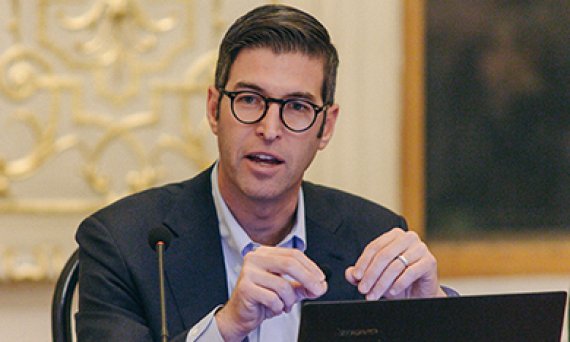Architect Michael Arad gave a lecture on the creation of the memorial to the victims of the September 11, 2001 terrorist attacks in New York. Arad was the memorial’s designer and gave a lecture at EUSP as part of the Department of Art History’s Open Research Seminar, with support from the United States Consulate General in St. Petersburg. Arad began with his own story of the project’s creation, starting with his personal impressions of the tragic day observed from the roof of his own home, and ending with the opening ceremony of the memorial on the tenth anniversary of the attack.
Called “Reflecting Absence” and intended to express a sense of irreparable loss, the memorial represents a “void that can never be filled.” Two pools situated below the level of the surrounding plaza—each in the footprint of one of the Twin Towers — are edged by bronze panels inscribed with the names of the 2,983 victims of the terrorist attacks. The National September 11th Memorial is dedicated not only to those killed at the World Center, but also to victims of the attack on the Pentagon and the passengers of the hijacked airliner that crashed in Pennsylvania. Thin streams of water pour from the bronze-framed perimeter and unite to form a cascade that falls from 10 meters, symbolizing each life and the loss on a national scale. The concept of voids, refers to ideas of the architect-deconstructivist Daniel Libeskind, who embodied them in the structure of the Jewish Museum in Berlin. Libeskind was chosen to evaluate the master plan of rebuilding the territory surrounding the former World Trade Center, of which the Memorial became a part.
Arad elaborated on each stage of negotiating the memorial’s original design, which he had thought up even before the competition was announced. Libeskind’s master plan, for example, called for an area below the level of the surrounding buildings, which, according to Arad, contradicted the idea of public space designed to unite people experiencing a shared sense of loss. The space of the memorial was supposed to be an integral part of everyday life in the city where people live, work and play. That is why Arad insisted that the plaza—Memorial Plaza—remain flush with the adjacent buildings, and that trees be planted throughout the complex.
No less important to Arad was the issue of positioning the names of the victims on the memorial panels. Fulfilling this objective required that he both emphasize the significance of each human life, as well as reflect the collective nature of the loss. Arad came upon a solution with the concept of “meaningful adjacency,” which was designed to show multiple links between the victims of the attacks. While the idea was at first rejected as too expensive and difficult to implement (it implied a large-scale survey of relatives of the victims) an alternative was found supposing an alphabetical arrangement of the names and classification by place of work or place of death.
The competition for designing a memorial to the victims of the September 11th, 2001 terrorist attacks was announced in 2003 by the Lower Manhattan Development Corporation. In January 2004, the joint-project by Michael Arad and landscape architect Peter Walker was chosen among eight finalists. The memorial officially opened on September 11th, 2011, on the ten-year anniversary of the tragedy. The Memorial Museum began operating on May 21, 2014, and was visited by over a million people only three months after inauguration.
Sofya Abasheva, Alina Novik















